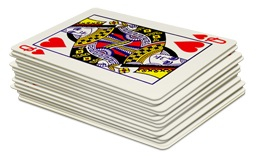[Post by Rex Hammock]

According to one theory, the word ‘deck,’ when used after the word PowerPoint, is inspired by a deck of cards and serves a metaphor for how one can arrange and shuffle the slides created on software like PowerPoint and Keynote. However, anyone over the age of 40 or who has watched Mad Men knows that old-school presentation slides weren’t stacked in decks, but were placed in the circular part of a time machine called the Kodak Carousel.
On Wednesday, the White House posted an “enhanced version” of the President’s State of the Union address on Slideshare. (If you’re reading this on the Hammock Blog, it should be embedded below.) The enhanced version is a 107-slide, yes, 107-slide PowerPoint deck. As PowerPoints go, the quality of the graphics and design are superior to 99% of the PowerPoint decks you and I have ever endured. In other words, no deficits were reduced in the production of this 107-slide PowerPoint deck. (Have I mentioned there are 107 slides in the deck?)
But is a PowerPoint deck, even a great one, the best medium to use for after-the-presentation communications?
Read on, and you’ll understand why I say, “No.”
At Hammock, one of the things we do is work with large companies to develop sales presentation systems that are intended to help lead a customer to make the decision to buy a specific product or service. The presentations in these systems don’t merely run through concepts, and, most of all, they don’t just serve as an outline to remind the sales person the next thing they want to say. They sell something.
When we first start working with a client, the most shocking thing (to the sales person, at least) seems to be when we tell them this: Never give out your deck following a presentation!
Why is it shocking? Because that seems to be a universal practice. The prospect sees something they want to remember and asks politely and with interest, “Hey, can you give me a copy of this presentation?” The sales person, not having anything else to give them, says, “Sure.”
Seems harmless enough, so why would we suggest banning the practice?
It’s certainly not that we don’t want the presentor to provide the prospect with something that can lead to a sale. Indeed, we think that being asked for a copy of ones presentation is at least a base hit and is something good that you want to happen. We just don’t believe the presentation deck is the best medium to use when trying to advance the sales process.
Here are our three reasons for NOT handing out your sales presentation PowerPoint deck:
- A presentation deck is not a leave-behind – it’s not even the presentation: Consider your presentation as a theatrical performance: It’s a drama complete with a stage and audience. On the stage, there is an actor (the presenter) and there is scenery (the imagery projected up on the screen). After attending a Broadway show, I can recall wanting the script of a play, or perhaps the CD of the music. But I can’t recall ever thinking that it sure would be nice to have a PDF of the scenery. Using this analogy, we strongly believe you should think of the presentation as being, first and foremost, the story that is being conveyed through the words and actions of the persenter. The deck is, at best, like great scenery that can add power to the story telling. But, like scenery, the deck is rather useless without the actors standing before it, doing what actors do. You are the presenter. You are the presentation. The images on the deck are, at best, great scenery. (Sidenote: If your presentation is merely a bullet point version of a script, you need to know that the requests you are receiving for it are related to the power your deck may have as a sleeping aid.)
- You lose all message continuity in a “second-degree” presentation: Think of the presentation you make face-to-face with an individual or group as a “first-degree” presentation (in the Kevin Bacon sense of the word.) In that first-degree setting, two things happen that make it unique in the sales process: A. You control what you say and how you say it. B. The audience controls what they think you say and how they think it fits into their own context. Accept this: It’s a miracle whenever what you say and what the audience hearscome anywhere close to being the same. And that’s in a first-degree situation when you’ve got control of everything that is said and shown. Now, think about the odds against your message being accurate when it is being conveyed by a person to whom you hand over your deck. Consider how they’ll be sharing it with a person you’ve never met.In a bullet-point version of what will occur, let’s turn to the words of the Captain in the movie, Cool Hand Luke:
- What you’ve got there
- A failure to communicate
- Your deck is the wrong medium for the right opportunity: We work with each client to develop a presentation system that corresponds to their sales process. If a prospect requests a presentation deck, our clients provide them what we call a “second-degree presentation.” Rather than being a copy of the first-degree presentation, they use different formats or software platforms. Some use graphics from the presentation, but are designed to be self-contained and crafted for an individual to read or watch. Some make use of short video segments an individual can play-back themselves. (No, a video of your 45-minute presentation won’t work.)

The take-away bullet point: It’s hard enough to use a PowerPoint effectively with people you’re close enough to touch. It’s asking the impossible to make those slides assume magical powers and present themselves when you’re not around.

